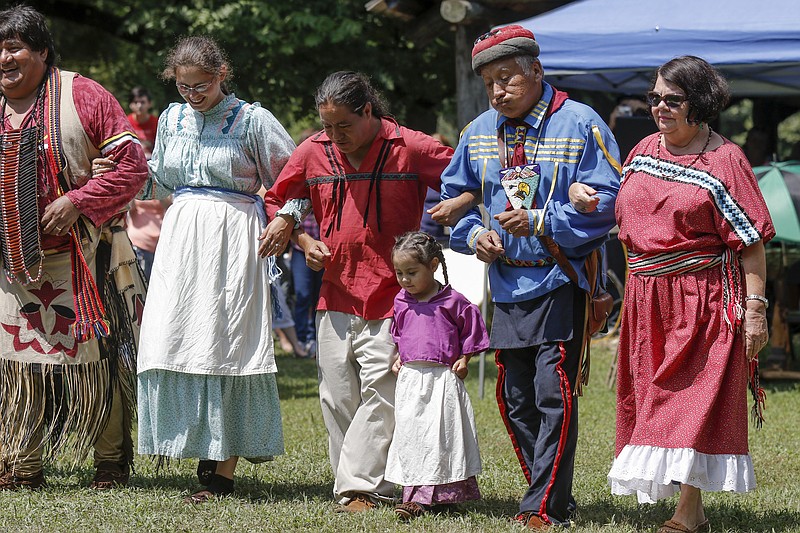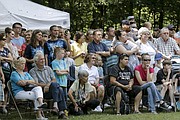Photo Gallery
Tri-Council of the Cherokee discuss cultural preservation, unity in historic meeting at Red Clay
RED CLAY, Tenn. - A breeze stirred the three tribal flags of the Cherokee people who converged at the site of the original Council House here.
The flags represent the first time all three tribes have met at Red Clay since Chief John Ross announced passage of the Indian Removal Act and the tragic change in destiny for the Cherokee who remained in their homeland.
"It was emotional," Brandon Jones, Eastern Band of Cherokee Indians tribal councilman, said as he strode from the flag ceremony to the original Council House site, just a few steps from the Cherokee Blue Hole spring on sacred ground.
About 200 people attended the flag-raising ceremony and a Tri-Council meeting of the three federally recognized Cherokee tribes. Resolutions were discussed and debated, songs were sung by Cherokee children and many Cherokee who had never met joined together to celebrate as one family.
"I came here as a child, but I didn't really understand what this place means," Jones said, his voice breaking as he led his children through the grass. "Now my kids and family come here, and I teach them the legacy and show them what's going on. It has so much meaning now for all of us."
The Tri-Council meeting Friday concluded a week of meetings for the Cherokee Nation tribe from Oklahoma; Eastern Band of Cherokee in Cherokee, N.C.; and the United Keetoowah Band, also of Oklahoma. Altogether the three tribes number more than 360,000 members. Much of the meeting was conducted in the Cherokee language, with occasional interjections of English translations.
The council discussed a series of resolutions, concentrating on preservation of language and culture, including Sequoyah's original syllabary - the Cherokee alphabet with pronunciation guide. It was used for years to teach children the Cherokee tongue. The Eastern Band of Cherokee Indians hosted the meeting.
It was clear that Friday's gathering was about something important. Children's voices rose in Cherokee song as tribal elders smiled with pride during the meeting's opening. Leaders were arranged in a circle on a council floor strewn with wood chips under the pole-and-beam, open-air Council House. Remote-control cameras and microphones piped the discussion to an adjacent covered tent, where a gallery of people sat to listen.
The Eastern Band's "Beloved Man" Jerry Wolfe welcomed his "brothers from down the road" and urged that they remember that "language is our identity."
This emerged as the theme. Measures were considered to acknowledge the efforts of the Cherokee Language Consortium and the Sequoyah Birthplace Museum in Vonore, and to establish requirements that any changes to Sequoyah's original syllabary be approved by the Tri-Council.
That's where the panel snagged.
Cherokee Nation Speaker Joe Byrd took the position that Sequoyah's work should be preserved as is, so no changes should ever be allowed. The meeting was recessed while the parts of the resolution were rewritten, netting unanimous approval. The language was protected.
Another approved resolution requires the authentication of Cherokee presenters who speak to the general public, aiming to make sure historical and cultural information is accurate and consistent. Also approved was a resolution that endorsed the exercise of tribal sovereign rights regarding food production and distribution among Cherokee. Council members said the resolution is important because it addresses many of the health problems Cherokee experience.
Tribal council Chairwoman Terri Henry told fellow council members that the Tri-Council meetings, held annually for several years, are about "nation-building in the 21st century."
"We must have an understanding of what nationhood was and what it is in this new era," she said.
Cherokee Nation Chief Bill John Baker called the experience "humbling."
"We came out here about 5 o'clock this morning and waited for the sun to come up, and we went to water just like our ancestors did 175 years ago," Baker said. "We felt a kinship that was almost like a religious experience."
United Keetoowah Band Chief George Wickliffe, who, like his band, resists change, proudly noted the Keetoowah chose to leave the mountains and were not forced out in the Removal. The Keetoowah left the South for Arkansas in the early 1800s because they disagreed with other Cherokee who wanted to pursue a "civilized" life.
"We are the original Cherokee people," Wickliffe proclaimed. "We are the ones, the tribe, that took the fire from Clingman's Dome mountain when God gave us our religion."
Unlike the other two tribes, the Keetoowah never met at Red Clay. Friday was Wickliffe's first visit.
The Cherokee Nation were the ones who were marched west on the Trail of Tears, and the Eastern Band are those who resisted and hid in their homeland until land was preserved for them in North Carolina.
Wickliffe recognized the importance of the three tribes coming together at the historic spot.
"Today, I take away from this - unity," he said.
Contact staff writer Ben Benton at bbenton@times freepress.com or twitter.com/BenBenton or www.facebook.com/ben.benton1 or 423-757-6569.

